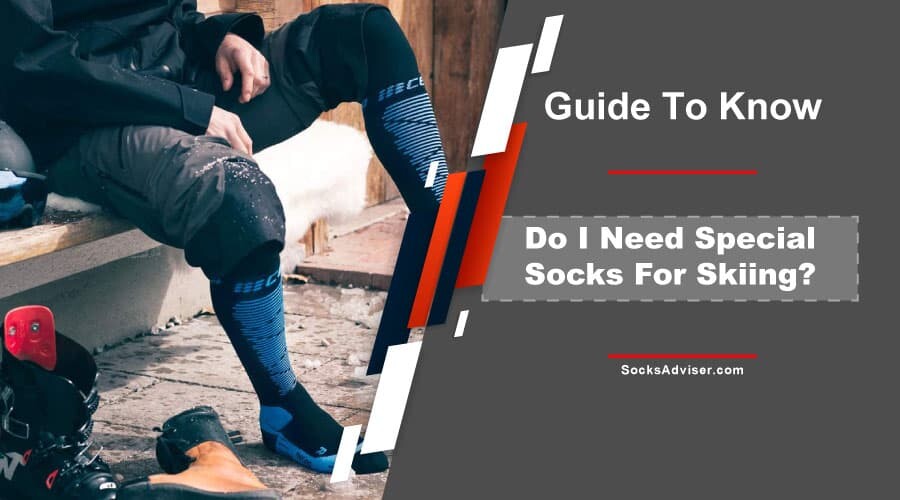Skiing is a fun, recreational, or competitive winter sport. And during skiing, the most active body part is your feet. Therefore, the first law is to keep your feet comfortable and safe. To do so, wearing special ski boots (Amazon) is good. But, ski experts recommend you to choose special socks ( ski socks [Amazon] ) before buying the shoes.

So, do you need special socks for skiing? The answer is – yes. Because these socks are specially designed for most skiing challenges like it offers warmth, prevent blisters, and provide comfort. Note: Avoid regular socks, especially cotton socks, when skiing.
Without further ado, stick with us for more about why you need special socks for skiing.
Why Do You Need Special Socks (Ski Socks) For Skiing?
Ski socks are the most overlooked gear of ski wear. Your skiing performance heavily depends on the type of socks you’re wearing. The wrong socks can lead to sore and cold feet or even blisters. Also, your feet aren’t sufficiently protected without it, and hence, exposed to friction.
So, you might have the best skiing boot, but it’s nothing without the right ski socks. That is why ski experts recommend you choose ski socks before buying the shoes. They also advise that you try the boots with socks before skiing.
Read also: Do You Need Special Socks For Trampoline? Or, Do You Need Special Socks For Sky Zone?
What Kind Of Socks To Wear For Skiing?
Thin socks. Amazingly, thin socks offer much warmer feet than thick socks while skiing. You can also wear a mid-weight but avoid wearing cotton socks. This is because when your feet heat up, cotton will retain work, making the feet cold. So, how many socks to wear skiing? One pair of socks is enough for skiing.
Maybe now you are looking, what are the best socks for skiing. Well, ski experts suggest merino blend wool socks or ski tube socks that have high-tech insulation. For more, see our socksadviser’s best five ski sock picks.
Socksadviser’s Ski Sock Picks:
- Merino wool ski socks: PureAthlete High-Performance Wool Ski Socks [Amazon]
- Best heated socks for skiing: Snow Deer Heated Socks (electric ski socks) [Amazon]
- Best Budget Ski Sock: Unigear Ski Socks for Men Women [Amazon]
- Best ski compression socks: CEP Men’s Winter Ski Merino Compression Socks [Amazon]
- Best thin silk ski socks: FoxRiver Women’s Lightweight and Silk Ski Socks [Amazon]
How To Choose Ski Socks?
The best skiing socks are snug-fitting, long, moisture-wicking, thin, and lightweight. The recent models feature a new design with a better fit, moisture management, and breathability.
In addition, ski sock technology has evolved over the years, with modern ones offering better performance. So, choose ski socks with a better fit, breathability, and excellent moisture management to your feet.
Read also: Is It Better To Run With Thick Or Thin Socks?
Below are some things to consider when choosing a pair of ski socks.
1. Fabric Type
What are ski socks made of? Most ski socks contain a synthetic blend fabric or merino wool. So consider the fabric that has exceptional breathability and moisture-wicking properties.
Because:
- Wool is odor-resistant properties and warmth, even when wet.
- Synthetic blends have grown in popularity, especially among people with sensitive skin.
2. Length
Knee-high socks are perfect. Also, the minimum ski socks length is as tall as the boots. Besides, you should avoid calf or ankle-length socks as they easily slip to the ankle. They also expose your shin to friction from boot-shin rubbing.
3. Socks thickness
The most exciting fact about ski socks is that the thin socks are warmer than the thicker ones. However, thick socks can decrease circulation, especially with tight-fitting boots. They also keep sweat hence making your feet feel cold. So, choose thin socks as your ski socks.
4. Socks cushioning
Ski socks with zero cushions are the best to feel the terrain. Top skiers prefer this type of socks since their ski-shoe offers enough cushioning. Also-
Light cushioning: This cushioning is perfect for people susceptible to irritation. This type of ski socks has reinforced knitting on heels and toes. They also have padding on the shin to prevent shin-boot rubbing.
Medium cushioning: Best for those with loose-fitting skiing boots.
Heavy cushioning: It is ideal for skiers who visit areas with extremely low temperatures prefer them.
Final Words
To achieve maximum performance, wearing special socks is a must. It helps keep your feet warm, comfortable, avoid sweat, and protects them from blisters. So try the boots with socks before skiing.
